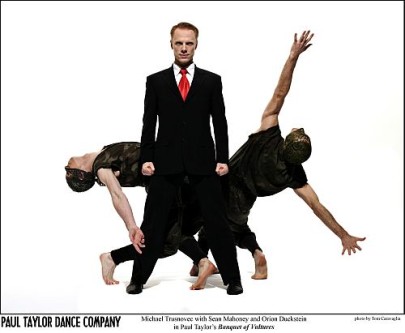 United States Paul Taylor, Airs, Banquet of Vultures, Gossamer Gallants: Paul Taylor Dance Company, Dorothy Chandler Pavilion, Los Angeles, 11.4.14-13.4.14 (JRo)
United States Paul Taylor, Airs, Banquet of Vultures, Gossamer Gallants: Paul Taylor Dance Company, Dorothy Chandler Pavilion, Los Angeles, 11.4.14-13.4.14 (JRo)
![Airs. Photo by Paul B. Goode.[1]-500](https://seenandheard-international.com/wp-content/uploads/2014/04/Airs.-Photo-by-Paul-B.-Goode.1-500.jpg)
Joyful, uplifting, poetic – three words that describe Paul Taylor’s choreography in one of his signature works, Airs, and the first dance on Friday night’s program at the Dorothy Chandler Pavilion. Created in 1978, Airs encapsulates much of what is so satisfying about Taylor’s work: expressiveness at the service of intellect, the perfectly calibrated repetitions that reinforce the choreography but never overwhelm it, the gestures that never feel arbitrary or overly manipulated.
The eagerly anticipated return of the Paul Taylor Dance Company to Los Angeles after a ten year absence was marked by a deeply satisfying trio of dances commenting on the nature of man and civilization: from the power of civilization to shape man’s better nature in Airs, to the loss of humanity through the tyranny of war in Banquet of Vultures, to the humor inherent in seeing our own foibles reflected in the insect world in Gossamer Gallants.
Scored to an array of selections from Handel, Airs makes reference to man’s higher nature where happiness is in reach and light shines on our endeavors. From adagio to allegro sections, the choreography dazzles with arms sculpting air, bodies tilting in space, and legs and feet beating in rapid-fire succession. The dancers are extraordinarily adept at Taylor’s demanding choreography – one of his most balletic of dances – and though they glow with a free and easy spirit, the precision, strength, and control required for the complex choreography is immense. The cast of four women and three men (I loved the asymmetry here), featuring Laura Halzack, Jamie Rae Walker, Robert Kleinendorst, and Michael Trusnovec, was splendid. Whether putting one in mind of classical Greek sculpture, wrestling moves, circus stunts, or folk dance, the lyricism of the music and choreography was captured by these seven highly musical dancers.

If Airs is about man achieving the heights, then Banquet of Vultures is focused on the depths. Where Airs soared, Banquet felt anchored to the floor, earthbound and rooted in the degradation of war. Banquet premiered in 2005, and Taylor famously commented that it was George W. Bush’s pseudo-military body language which first inspired the creation of the central malevolent character.
Dressed in a dark suit, white shirt, and red tie, Michael Trusnovec, with his imposing stature, created an iconic tyrant/ bureaucrat, himself little more than a puppet of the relentless war machine. With staccato marionette movements, he swaggered, threatened, and abused. Prisoners, dressed in generic camouflage-style uniforms, cowered and ran.
What distinguishes this anti-war work is Taylor’s minimalist aesthetic. His music selection and the sculptural qualities of the lighting design served the piece well. Morton Feldman’s 1976 work, Oboe and Orchestra, with its piercing sounds, created the backdrop to this commentary on torture. Feldman’s music never lapsed into sentiment or sensuality, which would have lessened the power of Taylor’s creation. Jennifer Tipton’s extraordinary lighting became the entire set. Sculptural cones of light illuminated bodies in the darkness, angling from the side or defining space from above. In one of the most stirring images of the piece, a shaft of light defined a circular space that imprisoned three victims. As they writhed within the confines of light, they became as heroic as the ancient figures of the Laocoön. In a stirring sequence danced by Trusnovec and Jamie Rae Walker, Taylor created a macabre pas de deux for predator and prey, which ended in the violent death of the prey (Walker). And in the closing moments, a second figure in a suit and red tie (an iconic uniform created by Santo Loquasto) replaced the first tyrant, only to flap and flounder like a fish on a line. Perhaps another politician inevitably inheriting a corrupt war that he can neither control nor stop?
Though Taylor makes reference to George W. Bush, there is a timelessness to the piece – at moments it has a German Expressionist feel, at other times the Iron Curtain looms large. Like Kurt Jooss’ 1932 ballet, The Green Table, no matter who the politicians or battling soldiers, any and all generations at war can be seen in this shattering dance drama.
The evening was capped with a delicious confection called Gossamer Gallants created in 2011. Insects cavort on stage to village dances from the Czech opera The Bartered Bride by Bedřich Smetana. I will never be able to hear Smetana’s music again without imagining dopey, lovesick bugs mooning over predatory females in all their wiggling, vamping glory.
Against a backdrop of a ring of stone towers, insects enacted their mating rituals to hilarious effect in the setting of a Czech village. Particularly engaging was the choreography for the male bugs, helplessly enthralled by the females. Drunk on love, the men’s movements were quirky and unpredictable. The dances for the females, though charming, seemed to draw on a more standard range of typically girlish behavior. When finally the boy bugs realized that the end of romance meant disaster, they moved from interest and enthusiasm to terror and exhaustion. All the nuances of the comedy were deftly handled by the exuberant and accomplished company of eleven dancers.
With Loquasto’s adorable costumes ̶ black and iridescent blue superhero insect suits for the men and lime green sexpot suits for the women ̶ the effect was complete. Wings flapping, hands probing, antenna bobbing, the dancers inhabited their characters with unmitigated joy. In the process, they reminded us of the preciousness of all life and the sheer breadth of the body of work born from the inexhaustible mind of Paul Taylor.
Jane Rosenberg